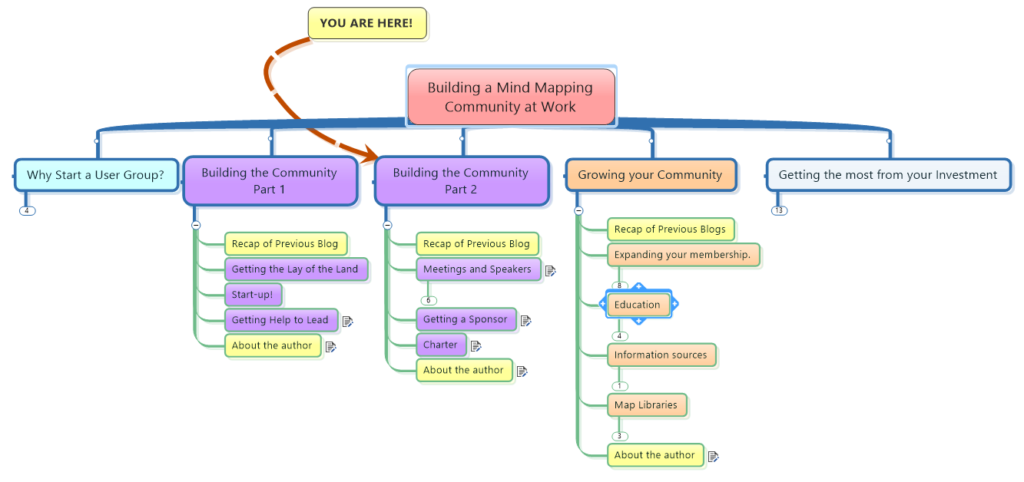By: David Halverson (Guest Blogger)
This is the third entry in a series of blog posts discussing the topic of building a mind mapping community within your company. You can read his full series by clicking on the links below:
- Why Start a Mind Mapping User Group?
- Building a Mind Mapping Community – Part 1
- Growing Your Mind Mapping Community

Recap
As the name implies, a community of mind mappers is a group of employees that have been exposed to mind mapping at some point and wish to further their personal skills or wish to promote mind mapping within their company.
In our second blog, we discussed:
- Getting the ‘lay of the land’ within your organization. You need to know this as you make plans for your community;
- What you need to start a community; and
- Getting help to lead your organization. You can’t do it all yourself!
You may want to read Part 1 and Part 2 to provide context for this one.
Planning Your Community Meetings

Previously Mindjet’s Customer Success Manager
Worked at The Boeing Company for 30 years
Before you have your first meeting, you and your community management team need to decide how you are going to advertise it what its purpose will be. Here’s a few pointers to get you started:
- My previous employer was a large international company spread around the globe. Our meetings drew employees from across the US and even as far as Australia. Our forum, necessarily, was conducted via phone and screen sharing. Our speakers were heard and their electronic mind maps and PowerPoint slides were viewed by as many as 700 people simultaneously. This worked well for what we wanted to accomplish. The speakers could make their presentations from their home office, allowing them to avoid costly travel.
- We found that the best time for meetings was at lunch during the middle of the week. Mondays and Fridays are problematic as you may have people on 4/10 or 9/80 schedules who cannot participate on those days.
- Start and end your meetings on time. Whatever times you have published for your meeting, strictly adhere to that schedule. Do not encourage late comers by starting late to accommodate their tardiness. Furthermore, don’t run overtime as you will instantly lose your audience at the scheduled end-time as your audience has other commitments.
- There are benefits to maintaining a regular schedule so that your audience can set that time aside in advance for your meeting, however, this didn’t work for me for several reasons. Firstly, this is not always possible as you may have a guest speaker that needs a different date or time so you have to accommodate. Secondly, there is also some benefit to moving the day of the week for your meeting to attract different people that may have a standing meeting during your regular meeting time. You have to decide which works best for your particular situation.
- Allow plenty of time for Q and A by your members. If their questions are too detailed, tell them that you will get back to them later on that topic and follow-up with answers in an email to your entire membership.
- If you have a face to face meeting that is longer than an hour, be sure to allow a generous break so that participants can talk with one another and get acquainted. Of course, some of the best ideas and sharing come from break-time conversations.
- An interesting concept for a long virtual meeting is to follow the pattern set up by most conferences where you have different speakers speaking on different topics at the same time. You can set up multiple conference calls and allow your attendees to pick the subject that they want to call into.
- Some companies have sophisticated video conference calling facilities. I have never found them particularly useful unless you plan on recording a presentation for part of your mind mapping library of presentations.
- As soon as you can, set up a website if your company allows this. This allows you to store presentations and other reference material for your membership in a centralized location. We’ll discuss this more later.
- Use your company’s intranet to announce meeting times, subjects and a snappy teaser for your members to help them decide if they want to attend. Obviously, you will need a big email distribution list here.
Planning Programs and Speakers
How do you plan for a meeting of your mind mapping community? Here’s some simple recommendations for a successful program:
- It’s important to know your audience. Take a survey of your community and find out what their job role is and where they work. This should help you tailor a program.
- On our community website we actually had a list of speaker topics that members could add to. We had some members make suggestions and we kept them on this site. Use a mind mapping tool such as MindManager for your presentations
- You may want to start out by getting your internal compatriots to show their maps and talk about how they use them. The BEST spokespeople for mind mapping are people in your company that you work with! Your fellow employees have instant credibility.
- Talk to your community leadership team and check the internet to find people that are mind mapping leaders nationally or internationally. Many of these leaders would be delighted to talk to your group about their particular use of mind mapping. You might be surprised at how many experts are willing to talk to your community especially if you are doing a telecon.
- Particulary effective was to have an external speaker for 40 minutes and then a few company employees share their own maps that are appropriate to the topic. Having employees show their work does two things; it validates the speakers message with internal expertise as well as giving your community members some well deserved visibility. You will make instant friends by asking people to speak at your meetings!
- Make your programs role based. Showing functionality of software does not show your audience how to use mind mapping in their jobs. You need to show them how to make their jobs better, faster or cheaper otherwise they won’t understand the benefit. Stick to benefits for specific roles.
Creating Your Community Charter
A charter is important for ensuring that everything you do falls within your plan. You can show the powers that be your plans and that you have your act together.
Here are a few ideas:
- Specify your objective in terms of benefit to your company. Squishy, feel-good objectives will not cut it with your management. They want to see dollars saved.
- Include the roles of your officers.
- Include how often you will meet and the resources that you are using.
- If you can get your sponsor to sign it, fantastic! That will go miles to your community’s credibility.
- You may want to include your ‘elevator pitch’ as your opening description. You can memorize that paragraph and when anyone asks you about the community, it will roll off your tongue!
Next blog
Part 4 of this blog series will discuss issues associated with starting and maintaining a mind mapping related community. The concepts are transferable to other types of communities as well, of course.
Talk soon!
About the Author:
Dave Halverson has teamed up with Jamie Nast, creator of Idea Mapping and internationally known trainer of over 25,000 students to offer a one-day course titled ‘Idea Mapping Using MindManager’.
Dave was previously Mindjet’s Customer Success Manager and worked for 30 years at The Boeing Company as a systems analyst, business analyst and project manager for various Boeing divisions. He was President and Director of the N/W Electronic Commerce Roundtable and 8 years ago started the Boeing Mind Mapping Interest Group which grew from a dozen members to over 600. He has also taught business at Bellevue College and City University in Bellevue Washington. Dave can be contacted at blackdiamondmind@gmail.comor Jamie through her website.

